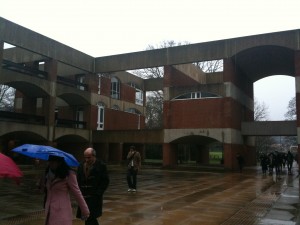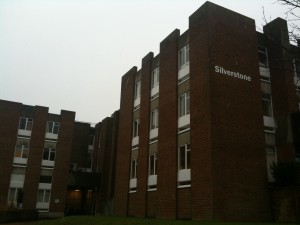Academic events come and go, and are sometimes quite unremarkable occasions; at their worst, there can be an underlying feeling of ‘going through the motions’. Attending ‘The Work of Roger Silverstone’ at the University of Sussex yesterday, I felt very far from one of those mundane academic gatherings. This was Silverstone encapsulated in a very engaging day. Not just his work as the title suggested, but who he was as an intellectual, a work colleague, and ultimately a human being.

Spence's University of Sussex campus
The occasion itself was to mark the naming of a new Silverstone Building. I’ve never been the University of Sussex before (though I’ve passed by it on the train), but what struck me immediately on arriving was the sheer coherence of the campus (designed by Scottish architect Basil Spence). I imagine much concrete and brick must have descended on this place in a very short span of time. Though I didn’t walk across the whole campus, I couldn’t find a single building outside of the original aesthetic.

Silverstone Building, University of Sussex
The new Silverstone Building, it turns out, is not a new building but a new name for an older building. As Sue Thornham joked in her welcome to the audience – shiny new buildings are the sort of thing reserved for business schools.
I particularly thought Caroline Bassett started things off well with a portrait of three strong aspects of Silverstone’s work. The first, predictably grabbing my attention, was that Silverstone was defined by being simultaneously fascinated by technology, McLuhan and medium theory, and at the same time, connected to the Birmingham School of Cultural Studies, which was some balancing act. Second was Silverstone’s particular attention to what Basset called the ‘poetics of everyday life’, for which he drew on many disciplines (sociology, geography, anthropology) and approaches (ethnography, phenomenology). Finally, was Silverstone’s turn to ethics late in life, and his identification of what he considered to be a moral crisis of global communication.
As a relative outsider to the crowd at this event, I went away seeing all three of these reflected most interestingly through the many discussions of and references to the ‘domestication framework’, for which Silverstone’s work (such as his Television and Everyday Life) has been a strong influence. This refers to the ways media technologies start out as something radically new, but then are rendered into aspects of everyday life which are taken for granted. For Silverstone, this told not only a story about the role of media and technologies in everyday life, but one about the uneven interference of private and public worlds. Ultimately, Silverstone presents us with an almost environmental view of media and public life, in which we confront a public world through a milieu of media technology, which we typically do not make problematic. For those more familiar with Silverstone this is old hat, perhaps; but I found the notion of domestication to be compelling – even accepting its theoretical and metaphorical issues (as pointed out several times in the course of the day). It will certainly feature in my reading and teaching this year … time for an online book search.
[…] rather different University of Sussex than the one I recounted on my visit in February for an event dedicated to Roger Silverstone (and the naming of a new Silverstone Building on campus). The riot police shown in the clip embody […]